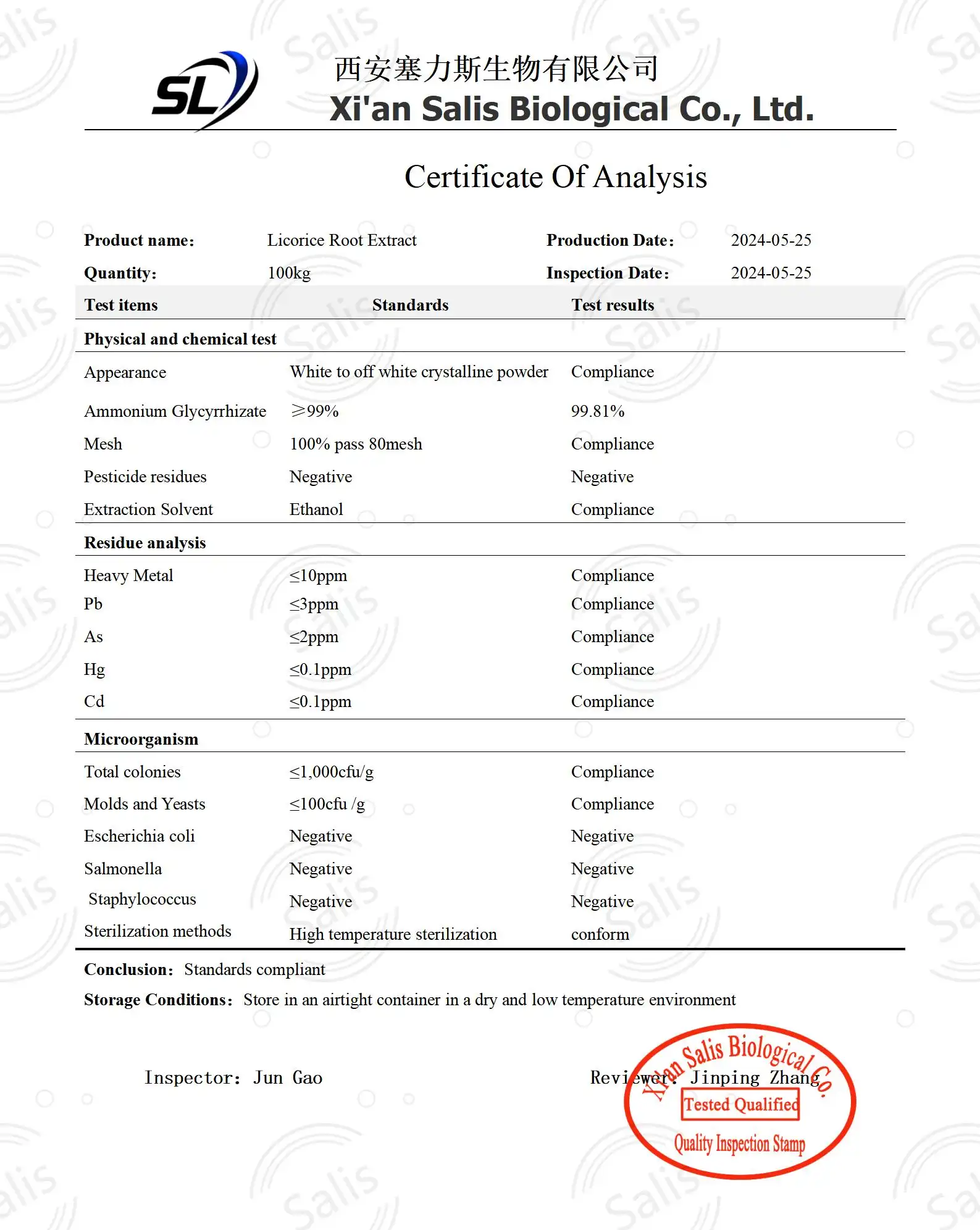Ammonium Glycyrrhizate, a compound derived from licorice root, has gained significant attention in the skincare industry for its potential benefits in improving skin elasticity. As we age, our skin naturally loses its elasticity, leading to sagging and the formation of wrinkles. Many skincare enthusiasts and professionals are turning to innovative ingredients like Ammonium Glycyrrhizate to combat these signs of aging and maintain youthful, supple skin. In this blog post, we'll explore the potential of Ammonium Glycyrrhizate in enhancing skin elasticity and address some common questions surrounding this promising ingredient.

How does Ammonium Glycyrrhizate work to improve skin elasticity?
Ammonium Glycyrrhizate works to improve skin elasticity through several mechanisms. Primarily, it acts as a powerful antioxidant, protecting the skin from free radical damage that can break down collagen and elastin fibers. These fibers are essential for maintaining skin's structure and elasticity, and their preservation is crucial for youthful-looking skin.
Additionally, Ammonium Glycyrrhizate has been shown to have anti-inflammatory properties. Inflammation can contribute to the breakdown of skin's supportive structures, so by reducing inflammation, this compound helps maintain skin integrity. It also has a moisturizing effect, which is important for skin elasticity as well-hydrated skin is more resilient and supple.
Research has indicated that Ammonium Glycyrrhizate may stimulate the production of hyaluronic acid in the skin. Hyaluronic acid is a naturally occurring substance in our bodies that helps retain moisture and promote skin elasticity. By boosting hyaluronic acid levels, Ammonium Glycyrrhizate can contribute to improved skin hydration and elasticity.
Furthermore, some studies suggest that Ammonium Glycyrrhizate may have a mild inhibitory effect on certain enzymes that break down collagen and elastin. By slowing down this breakdown process, it could help preserve skin's natural elasticity for longer periods.
It's important to note that while these mechanisms show promise, the effects of Ammonium Glycyrrhizate can vary from person to person. Factors such as skin type, age, and overall skincare routine can influence its effectiveness. As with any skincare ingredient, consistent use over time is typically necessary to see noticeable improvements in skin elasticity.
What are the best ways to incorporate Ammonium Glycyrrhizate into a skincare routine?
Incorporating Ammonium Glycyrrhizate into your skincare routine can be done in several ways to maximize its potential benefits for skin elasticity. Here are some of the best methods to include this ingredient in your daily regimen:
1. Serums: Ammonium Glycyrrhizate is often found in concentrated serums. These products are designed to deliver active ingredients deep into the skin. Apply a serum containing Ammonium Glycyrrhizate after cleansing and toning, but before moisturizing. This allows the ingredient to penetrate the skin effectively without barriers.
2. Moisturizers: Many moisturizers now include Ammonium Glycyrrhizate in their formulations. Using such a moisturizer twice daily can provide a consistent dose of the ingredient to your skin, helping to maintain elasticity over time.
3. Face Masks: Weekly treatments with face masks containing Ammonium Glycyrrhizate can give your skin an extra boost. These masks often provide a higher concentration of active ingredients and allow for longer contact time with the skin.
4. Eye Creams: The delicate skin around the eyes is often one of the first areas to show signs of aging and loss of elasticity. Eye creams formulated with Ammonium Glycyrrhizate can be particularly beneficial for maintaining elasticity in this sensitive area.
5. Toners: Some advanced toners include Ammonium Glycyrrhizate. Using such a toner can prep your skin to better absorb subsequent products while providing the benefits of this ingredient.
When incorporating Ammonium Glycyrrhizate into your routine, it's important to start slowly, especially if you have sensitive skin. Begin by using products containing this ingredient every other day and gradually increase frequency as your skin adjusts. It's also crucial to pair Ammonium Glycyrrhizate with sun protection, as many anti-aging ingredients can increase skin sensitivity to UV rays.
For optimal results, consider using Ammonium Glycyrrhizate in combination with other skin-beneficial ingredients like hyaluronic acid, vitamin C, and retinol. However, always consult with a dermatologist or skincare professional before making significant changes to your skincare routine, especially if you have any existing skin conditions.
Remember that consistency is key when it comes to skincare. The effects of Ammonium Glycyrrhizate on skin elasticity are not immediate and may take several weeks or months of regular use to become noticeable. Patience and persistence in your skincare routine will yield the best results in improving and maintaining skin elasticity.
Are there any skin types that benefit most from Ammonium Glycyrrhizate?
While Ammonium Glycyrrhizate can be beneficial for various skin types, certain skin conditions and types may see more pronounced benefits from its use. Understanding which skin types benefit most can help individuals make informed decisions about incorporating this ingredient into their skincare routines.
Mature Skin: As we age, our skin naturally loses elasticity and firmness. Mature skin types often benefit significantly from Ammonium Glycyrrhizate due to its potential to improve skin elasticity and reduce the appearance of fine lines and wrinkles. The antioxidant properties of this ingredient can help protect aging skin from further damage caused by free radicals.
Dry Skin: Ammonium Glycyrrhizate has moisturizing properties that can be particularly beneficial for dry skin types. It helps in retaining moisture within the skin, which is crucial for maintaining skin elasticity and preventing the formation of fine lines due to dehydration.
Sensitive Skin: Due to its anti-inflammatory properties, Ammonium Glycyrrhizate can be suitable for sensitive skin types. It may help calm irritation and redness, making it a gentler alternative to some other anti-aging ingredients that might be too harsh for sensitive skin.
Combination Skin: For those with combination skin, Ammonium Glycyrrhizate can be a balanced choice. It provides hydration to dry areas without excessively oiling up the T-zone, helping to maintain overall skin elasticity and health.
Acne-Prone Skin: While not primarily an acne treatment, the anti-inflammatory properties of Ammonium Glycyrrhizate can be beneficial for acne-prone skin. It may help reduce inflammation associated with acne while improving overall skin texture and elasticity.
Sun-Damaged Skin: Individuals with sun-damaged skin may find Ammonium Glycyrrhizate particularly helpful. Its antioxidant properties can aid in repairing some of the damage caused by UV exposure, potentially improving skin elasticity that has been compromised by sun damage.
It's important to note that while these skin types may see more pronounced benefits, Ammonium Glycyrrhizate can be beneficial for most skin types when used appropriately. The key is to find the right formulation and concentration that works best for your individual skin needs.
For those with oily skin, it's advisable to use lighter formulations containing Ammonium Glycyrrhizate, such as serums or gel-based products, to avoid excess oiliness. People with very dry or mature skin might benefit from richer creams or oils that contain this ingredient.
As with any skincare ingredient, it's always recommended to do a patch test before fully incorporating Ammonium Glycyrrhizate into your routine, regardless of your skin type. This helps ensure that you don't have any adverse reactions to the ingredient.
Conclusion
While Ammonium Glycyrrhizate can offer benefits to a wide range of skin types, those with mature, dry, sensitive, combination, acne-prone, or sun-damaged skin may see the most noticeable improvements in skin elasticity and overall skin health. Always consult with a dermatologist or skincare professional to determine the best way to incorporate this ingredient into your specific skincare routine for optimal results.
If you are also interested in this product and want to know more product details, or want to know about other related products, please feel free to contact lea_slsbio@163.com,WhatsApp+86 13193326505.

References
1. Zhang, L., et al. (2011). Glycyrrhizic acid and 18β-glycyrrhetinic acid: Natural products with anti-inflammatory and anti-cancer activities. Journal of Ethnopharmacology, 135(2), 406-412.
2. Saeedi, M., et al. (2015). Evaluation of the effect of glycyrrhizin on the pharmacokinetics of topical hydrocortisone in human volunteers. Iranian Journal of Pharmaceutical Research, 14(4), 1025-1033.
3. Yokota, T., et al. (1998). The inhibitory effect of glabridin from licorice extracts on melanogenesis and inflammation. Pigment Cell Research, 11(6), 355-361.
4. Maurya, S. K., & Kushwaha, A. K. (2010). Glycyrrhiza glabra: A miracle medicinal herb. Research Journal of Pharmacognosy and Phytochemistry, 2(2), 118-121.
5. Asl, M. N., & Hosseinzadeh, H. (2008). Review of pharmacological effects of Glycyrrhiza sp. and its bioactive compounds. Phytotherapy Research, 22(6), 709-724.
6. Shen, X., et al. (2019). Glycyrrhizin: A review of its anti-inflammatory and immune-enhancing properties. Biomedicine & Pharmacotherapy, 118, 109252.

